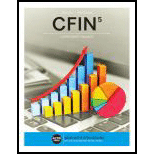
CFIN (with Online, 1 term (6 months) Printed Access Card) (New, Engaging Titles from 4LTR Press)
5th Edition
ISBN: 9781305661653
Author: Scott Besley, Eugene Brigham
Publisher: Cengage Learning
expand_more
expand_more
format_list_bulleted
Concept explainers
Question
Chapter 10, Problem 6PROB
Summary Introduction
Supplemental operating cash flows: Supplemental operating cash flows is also called as cash flow from operations. This are cash flows which are generated from the companies operating activities.
Calculate the supplemental operating cash flows by using the following formula:
CC is considering the purchase of an asset that saves cost of $110,000, cost of assets is $840,000 and life is 10 years.
Expert Solution & Answer
Want to see the full answer?
Check out a sample textbook solution
Students have asked these similar questions
Ineed soln
Soln of himlton problem.
No AI
this finance problem..
Chapter 10 Solutions
CFIN (with Online, 1 term (6 months) Printed Access Card) (New, Engaging Titles from 4LTR Press)
Knowledge Booster
Learn more about
Need a deep-dive on the concept behind this application? Look no further. Learn more about this topic, finance and related others by exploring similar questions and additional content below.Similar questions
- Solve this coarrow_forwardConsider an asset S with price function S = 2+2t S(t) = S=8-t for tЄ [0,2], for tЄ [2,4], St² 8t+20 for tЄ [4,6]. (a) Sketch the graph of S(t). - (b) Calculate the continuous arithmetic average of S over the interval 0 ≤ t ≤ 6. (c) Calculate the discrete arithmetic and discrete geometric average of S, where the discrete sampling points are take at times t = t; = ist for i = 0, 1, 2,...6 with St = 1. (d) What is the payoff of a European-style discrete geometric average rate call option which expires at t = T = 6 with E = 4.2? (e) What is the payoff of a European-style continuous arithmetic average strike put which expires at t = T = 6? (f) Consider a stop-loss option with λ = 5/6. At what time will this option be exercised? What will be the payoff?arrow_forwardFor UK Vodaphone,1(a)collect data from uk Vodaphone data annual report and Input data to all tables and each box individually with bellow law. Explain with 4 points: (a) explain the ratios (b)comment on the number in the table above. (c) Explain the reason why. (d)What do you think?). Within 1600 word Law: FIM Part I PDF Generative summary Gross margin Net margin Current ratio Cash AŞİR Debt equity ratio Debt capital ratio to to Asset turnover **Al Assistant I 20 Comment Highlight Underline Strikethr... Draw More to... 2020 2021 2022 2023 2024 2020 2021 2022 2023 2024 2020 2021 2022 2023 2024 Fixed asset turnover 1. (b) A critical assessment of the firm's working capital management over the same period. Again, you are advised to include graphical illustrate to support your answer. within 600 word 2020 2021 2022 2023 2024 Inventory days Inventory turnover Sales Profit Dixiend 2020 2021 2022 2023 2024 2020 2021 2022 2023 2024arrow_forward
- Solve it no ai.arrow_forwardConsider a Russian option with value function V(S, J) in the case where there are continuous dividends paid on the underlying asset S at rate D. Define the variable J for this option. A similarity reduction of the form W(n) = V/J with n S/J leads to 110²² W +(r− D)nW' rW = 0, which must be solved subject to - W(1) W'(1) = 0, W(no) = 1, W'(no) = 0, where n = ŋo is the optimal exercise boundary in similarity coordinates. The current value of the underlying is S = 3. What is the current value of the Russian option assuming that σ = 0.3, r = 0.1 and D = 0.05? Present your results to a minimum of 4 decimal places.arrow_forwardSolve it correctly plz.arrow_forward
arrow_back_ios
SEE MORE QUESTIONS
arrow_forward_ios
Recommended textbooks for you
 EBK CONTEMPORARY FINANCIAL MANAGEMENTFinanceISBN:9781337514835Author:MOYERPublisher:CENGAGE LEARNING - CONSIGNMENT
EBK CONTEMPORARY FINANCIAL MANAGEMENTFinanceISBN:9781337514835Author:MOYERPublisher:CENGAGE LEARNING - CONSIGNMENT Intermediate Financial Management (MindTap Course...FinanceISBN:9781337395083Author:Eugene F. Brigham, Phillip R. DavesPublisher:Cengage Learning
Intermediate Financial Management (MindTap Course...FinanceISBN:9781337395083Author:Eugene F. Brigham, Phillip R. DavesPublisher:Cengage Learning

EBK CONTEMPORARY FINANCIAL MANAGEMENT
Finance
ISBN:9781337514835
Author:MOYER
Publisher:CENGAGE LEARNING - CONSIGNMENT

Intermediate Financial Management (MindTap Course...
Finance
ISBN:9781337395083
Author:Eugene F. Brigham, Phillip R. Daves
Publisher:Cengage Learning

Capital Budgeting Introduction & Calculations Step-by-Step -PV, FV, NPV, IRR, Payback, Simple R of R; Author: Accounting Step by Step;https://www.youtube.com/watch?v=hyBw-NnAkHY;License: Standard Youtube License